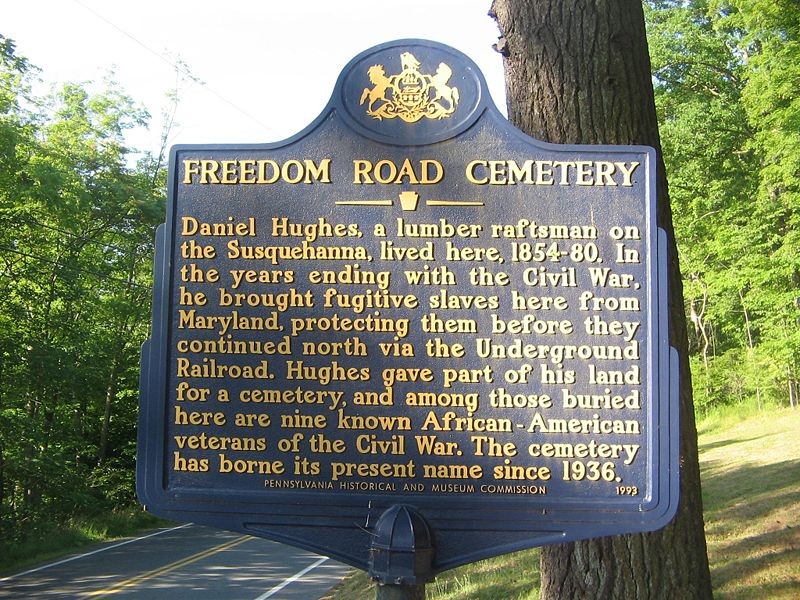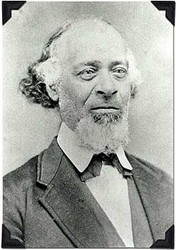Freedom Road Cemetery
Introduction
Text-to-speech Audio
This roadside marker notes the location of an African American cemetery along the path of the Underground Railroad. The cemetery has born its present name since 1936 and is the known burial site for nine African American veterans of the Civil War.
Images
The historical marker for the Freedom Road Cemetery near Williamsport, Pennsylvania

Daniel Hughes

Backstory and Context
Text-to-speech Audio
The land for the Freedom Road Cemetery was given by Daniel Hughes, an African American lumber raftsman on the Susquehanna River between 1854 and 1880. In the years ending with the Civil War Hughes brought fugitive slaves from Maryland to his homestead, protecting them before they continued north via the Underground Railroad, which ran through the area. The Underground Railroad was a network of secret routes and safe houses used by nineteenth-century enslaved people of African descent in the United States to escape to free states and Canada with the aid of abolitionists and allies who were sympathetic to their cause.
As an owner of a barge on the Pennsylvania Canal, Hughes transported lumber from Williamsport, Pennsylvania (at one time the lumber capital of the world), to Havre de Grace, Maryland for processing. As a "conductor" on the Underground Railroad, Hughes made every return trip to Williamsport with runaway slaves hidden in the hold of his barge. He also provided shelter and sustenance to those runaways on his property before they continued their journey to freedom further north in the United States or Canada. Hughes's home was located in a small valley in the mountains north of Williamsport. It was a densely wooded area, covered with vines and dotted with a series of caves and\ passageways. Originally called Nigger Hollow, in response to concerned African American citizens of Williamsport the location's pejorative name was changed to Freedom Road in 1936 by the Williamsport City Council.
Hughes took on a role in the Underground Railroad movement in part because of his mixed racial background. The census of 1850 designated him as a mulatto, but he was also part Mohawk Indian. Hughes moved to Williamsport from his home in Oswego, New York, in 1828 and married Ann Rotch, a local African American freedperson.
Although Hughes operated in an area of the United States where slavery had long since been banned, many of his neighbors and townsfolk still disagreed with his stance on slavery. Hughes, his wife, and their sixteen children had to take care in hiding their work to liberate the slaves. The Fugitive Slave Law of 1850 allowed slave catchers to pursue runaway slaves into northern states when previously they had been, under the Fugitive Slave Law of 1793, forced to stop at the Mason-Dixon line. Allowing slave catchers to pursue runaways into the northern states made life more dangerous and difficult for all conductors, including Hughes, on the Underground Railroad.
Given local racial tensions, Hughes was forced to lead his rescuees under cover of darkness. Local bounty hunters and professional slave catchers from the South sought to capture any slaves that they could. Hughes and his sons tried to work on moonless nights. They also would stretch difficult-to-see horse hairs across the trails, causing the slave catchers to be thrown off the backs of their horses, either slowing their pursuit or deterring it entirely. Hughes led the fugitive slaves from his home to the next station near Trout Run on Lycoming Creek. From there the slaves would work their way north to Elmira, New York, and eventually to freedom in Canada.
As an owner of a barge on the Pennsylvania Canal, Hughes transported lumber from Williamsport, Pennsylvania (at one time the lumber capital of the world), to Havre de Grace, Maryland for processing. As a "conductor" on the Underground Railroad, Hughes made every return trip to Williamsport with runaway slaves hidden in the hold of his barge. He also provided shelter and sustenance to those runaways on his property before they continued their journey to freedom further north in the United States or Canada. Hughes's home was located in a small valley in the mountains north of Williamsport. It was a densely wooded area, covered with vines and dotted with a series of caves and\ passageways. Originally called Nigger Hollow, in response to concerned African American citizens of Williamsport the location's pejorative name was changed to Freedom Road in 1936 by the Williamsport City Council.
Hughes took on a role in the Underground Railroad movement in part because of his mixed racial background. The census of 1850 designated him as a mulatto, but he was also part Mohawk Indian. Hughes moved to Williamsport from his home in Oswego, New York, in 1828 and married Ann Rotch, a local African American freedperson.
Although Hughes operated in an area of the United States where slavery had long since been banned, many of his neighbors and townsfolk still disagreed with his stance on slavery. Hughes, his wife, and their sixteen children had to take care in hiding their work to liberate the slaves. The Fugitive Slave Law of 1850 allowed slave catchers to pursue runaway slaves into northern states when previously they had been, under the Fugitive Slave Law of 1793, forced to stop at the Mason-Dixon line. Allowing slave catchers to pursue runaways into the northern states made life more dangerous and difficult for all conductors, including Hughes, on the Underground Railroad.
Given local racial tensions, Hughes was forced to lead his rescuees under cover of darkness. Local bounty hunters and professional slave catchers from the South sought to capture any slaves that they could. Hughes and his sons tried to work on moonless nights. They also would stretch difficult-to-see horse hairs across the trails, causing the slave catchers to be thrown off the backs of their horses, either slowing their pursuit or deterring it entirely. Hughes led the fugitive slaves from his home to the next station near Trout Run on Lycoming Creek. From there the slaves would work their way north to Elmira, New York, and eventually to freedom in Canada.
In his later years, Hughes's son Robert recalled many details of his experiences on the Underground Railroad. He said about the runaways, "We would hide them in the woods in brush houses. I was just a little boy, but I remember very well carrying meals out to them in the woods. They usually traveled in groups of two or three men. Often patrollers would come to our place looking for runaways. They never caught anyone at our place. Rich people and good people in Williamsport, mostly Quakers helped in the work."
In a final act of support for runaway slaves and other African Americans, Hughes donated some of his land for the establishment of a cemetery, in which runaways who did not survive the journey were interred, along with several African American veterans of the Civil War. Hughes is also said to be buried in the cemetery in an unmarked grave.
Sources
Lou Hunsinger Jr., "Daniel Hughes: Giant of Freedom Road," Williamsport (Pa.) Sun Gazette, Feb. 15, 2012.
"Riots, Rumors, and Stories: The Underground Railroad Period in Pennsylvania's Heartland," June 2007, Pennsylvania Heartland Humanities Council, accessed Oct. 13, 2016, https://web.archive.org/web/20070626230005/http://www.forum4future.org/forum4future/lib/forum4future/ugrrrtourdraft72606_for_events.pdf.
